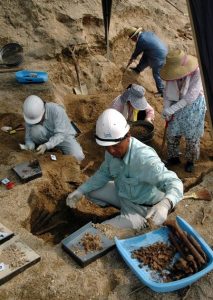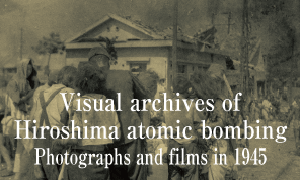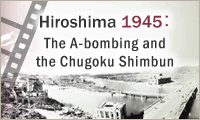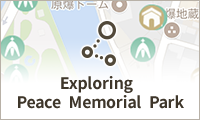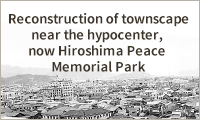Documenting Hiroshima 80 years after A-bombing: May 27, 2004, remains unearthed on Ninoshima Island
May 24, 2025
Remains of 85 individuals found along with many personal belongings
by Minami Yamashita, Staff Writer
On May 27, 2004, at the southeast part of Ninoshima Island (located in Hiroshima City’s Minami Ward), a remote island in Hiroshima Bay, a local vendor contracted by the Hiroshima City government began the work of excavating the island’s soil with heavy equipment. The excavation site was one area of the ruins of the former Japanese Imperial Army’s equine quarantine station, which had been turned into a mikan tangerine orchard after the war. Because testimonies reported that the bodies of A-bomb victims who had been brought to the island and died in the aftermath of the atomic bombing were buried there, a trial excavation was conducted at the site to search for any remains.
Local people demand excavation
Noboru Hirata, 78, who served as president of the Ninoshima federation of neighborhood associations at the time of excavation, said, “When we tried to develop a road in the area, elderly inhabitants of the island told us that ‘remains of victims’ bodies will be uncovered if you dig there.’ With that, we determined to unearth the remains also for the repose of their souls.” The Hiroshima City government, at first reluctant about the trial excavation, relented after Mr. Hirata made persistent demands for the excavation work.
In 1895, with the breakout of the Sino-Japanese war, a quarantine station had been established on Ninoshima Island as a way to prevent the spread of infectious diseases by soldiers returning from battle. Medicines and sanitary materials were stocked in the station, which became a provisional field hospital immediately after the atomic bombing on August 6, 1945. Until the hospital was shut down on August 25, it is said that around 10,000 victims had been admitted to the hospital, with the nearby stables of the equine quarantine station used as part of the hospital. Many bodies were initially cremated on site but, with too many to ultimately cremate, some were buried as they were.
Soon after the war ended, the city government collected the remains of victims from various locations on the island and erected a memorial monument. In 1955, the remains of around 2,000 of the bodies were moved to the Atomic Bomb Memorial Mound in Hiroshima’s Peace Memorial Park. In 1971, the remains of around 617 bodies were additionally unearthed on the island among the ruins of the equine quarantine station, but the city put off conducting trial excavations in the surrounding area, which was being used as tangerine orchard at the time.
As the 59th anniversary of the atomic bombing approached, Kenji Sumida, 66, an employee of a local civil engineering company contracted by the city to work on the excavation, engaged in the work with his older brother, Yoshikatsu, president of the company who died in 2019 at the of 68. As soon as the heavy equipment they were using dug down to a depth of around 70 centimeters, the remains of one body was discovered, upon which the work was switched to manual excavation.
Kenji said, “I spotted some white teeth scattered about, and when I dug further down, there was a skull. Because I found the remains quickly at the first spot we excavated, I felt it was the wish of the dead victims ‘wanting to be found.’”
Cooperation in manual work
When a full-scale investigation began the next month, local residents on the island lent their cooperation in the manual work. As a result, the remains of fragile, brownish-red remains piled three to four layers deep were discovered. Kenji said, “The place where the remains were buried had a distinctive, pungent odor. I saw a skull that appeared to be gritting his teeth while biting his arm, from which I could clearly imagine the horror of the war.” To convey the misery of the atomic bombing, the excavation site was shown to elementary school and junior high school students, with a stone grave marker placed nearby. Some bereaved family members would place their hands together in prayer there.
Artifacts such as rings and school uniform buttons thought to have been worn by victims at the time were uncovered from the site one after the other. By late July the same year, 2004, an area of around 659 square meters had been excavated, with the remains of 85 bodies and 65 personal items confirmed. The remains were stored in the Atomic Bomb Memorial Mound, and the personal items were archived at the Hiroshima Peace Memorial Museum. The name tags and seals of mobilized students who had died were returned to the bereaved families.
With the excavation site backfilled and turned into a vacant lot, the city leased the area from the national government in 2014 free of charge. Mr. Hirata and other local volunteers assigned to manage the space developed “a memorial square.” Based on a design created by Kenji, flowerbeds in the image of Ninoshima Island and the six rivers running through Hiroshima were created, along with a small hill named by the island’s elementary and junior school students. A sign explaining the excavation site to visitors was also erected.
In 2021, the Ninoshima Peace Museum opened. The museum, maintained by a group of Ninoshima historical volunteer guides consisting of local residents, displays the personal belongings of victims and other items.
(Originally published on May 24, 2025)

